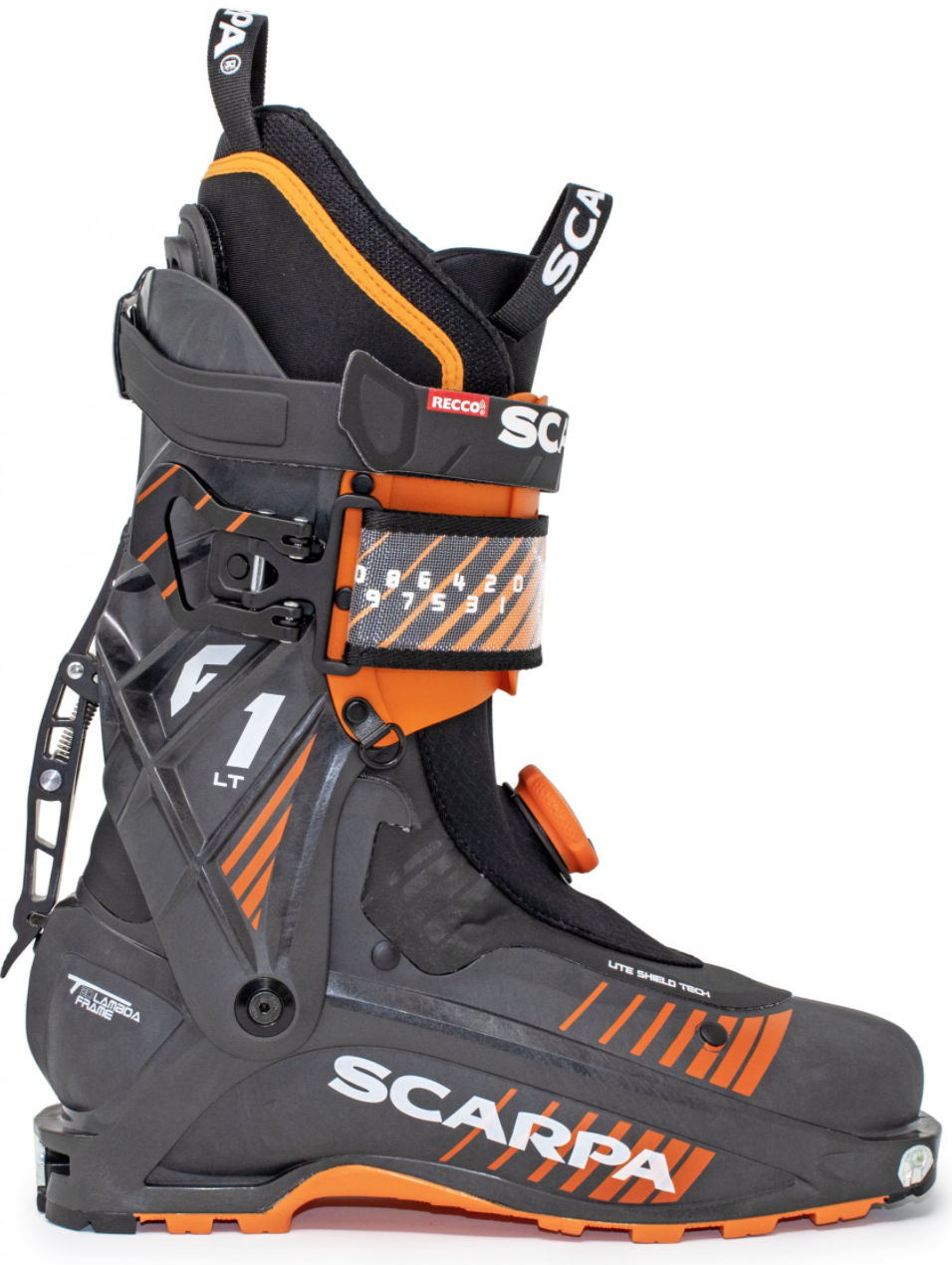 Over the last 20 years, or so, backcountry skiing and ski mountaineering equipment has seen a ton of innovation. I’ve been both an observer and consumer of much of it. Aside from the development of the tech binding in the 90’s, boots have been the recipient of some of the most profound improvements in material, design and performance. Much of this innovation has been driven by the skimo race segment of the sport and the trickle down effect of boot design from race to touring boots.
Over the last 20 years, or so, backcountry skiing and ski mountaineering equipment has seen a ton of innovation. I’ve been both an observer and consumer of much of it. Aside from the development of the tech binding in the 90’s, boots have been the recipient of some of the most profound improvements in material, design and performance. Much of this innovation has been driven by the skimo race segment of the sport and the trickle down effect of boot design from race to touring boots.
In my opinion, the hands down winner in this category for the modern off-piste skier is the Dynafit TLT 5 Performance boot in 2010. 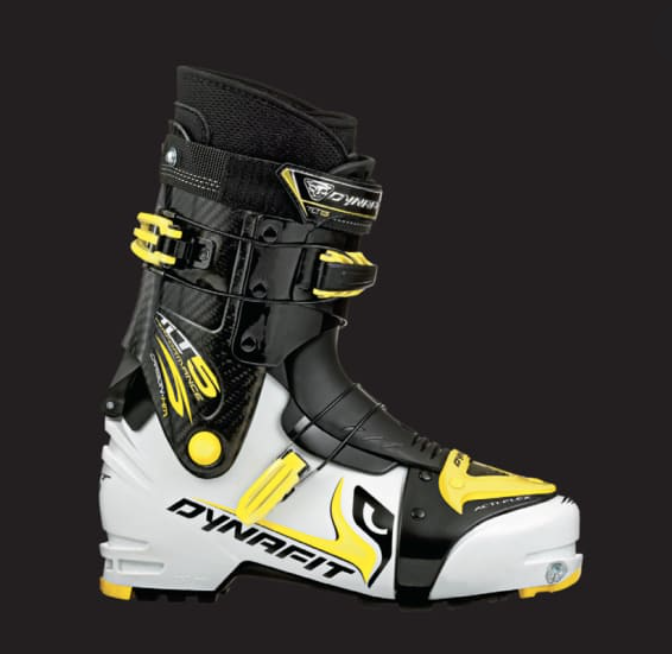 This boot set the standard for weight and a combination of uphill and downhill performance. Since then, many companies have attempted, with varying success, to build upon this benchmark. Each year, I expectantly wait for the “next big thing” only to be disappointed by the half-steps and small improvements.
This boot set the standard for weight and a combination of uphill and downhill performance. Since then, many companies have attempted, with varying success, to build upon this benchmark. Each year, I expectantly wait for the “next big thing” only to be disappointed by the half-steps and small improvements.
This season, while not necessarily revolutionary in the ways its predecessors were, the Scarpa F1 LT is the latest boot to earn the title “Game Changer” in my book. Now, I could be accused of being hyperbolic throwing that around and in some ways, I’m guilty. But that metric is delivered on the heels of what I think is some back sliding by the trend setters, including Dynafit.
Market pressure is a bitch and in an attempt to “fit” more feet, Dynafit expanded the fit and volume of its offering, sizing me out in the process but likely making more people happy. The big change happened with the TLT 7. After the TLT 5, a small expansion happened with the TLT 6 which I managed effectively with a thicker liner. All was good. But the TLT 7 went even bigger and I was out. At the same time, multiple players jumped into the light boot game with varying degrees of success. Much of the focus that created a boot that’s nice to skin in was transferred to the development of more downhill performance-oriented models and some very nice compromises were developed (think… Dynafit Hoji). At the same time, some companies shifted their focus to pure downhill performance in an attempt to have the best of both worlds. But I digress.
I remain committed to traveling far and accumulating more vertical than the average enthusiast. As I age, the performance characteristics that make this possible become even more critical as the engine flags. To this end, Scarpa has really stepped up with the F1 LT, creating a boot that is both incredibly stiff on the down, stupid light on the up and walks nearly like a race boot. What’s not to love? Well, let’s dig down on the details. That’s what you came for anyway.
History
My relationship with Scarpa goes back to the 90’s and my telemark days. After over a decade of floundering around on soft leather boots, the Terminator series they released were near revolutionary in terms of performance improvement.  Although I didn’t know better back then, in hindsight, my skinny ass foot swam around in those things. But adding plastic to your telemark quiver was such a massive step up, it was hard to notice.
Although I didn’t know better back then, in hindsight, my skinny ass foot swam around in those things. But adding plastic to your telemark quiver was such a massive step up, it was hard to notice.  The ubiquitous Scarpa F1 race boot.Later, in my skimo race days, the green F1 (see above) and the Alien were both must-haves for the majority of the field.
The ubiquitous Scarpa F1 race boot.Later, in my skimo race days, the green F1 (see above) and the Alien were both must-haves for the majority of the field.
For a few years, I strayed into other brands like Sportiva (Spitfire), Arcterx (Procline) and Dynafit (TLT 6 Performance). I avoided Scarpa then because of the size issue. Finally, one savvy Skimo Co employee who knew what I needed, convinced me to put my foot into the revamped F1. I was home. Although it does not walk as well as some, the overall blend of walk and ski performance along with a narrow fit kept me from looking elsewhere for two full seasons. I even stepped up for the much-hyped Alien RS and the Alien 1.0 for my spring mission needs.
With my ear always to the ground, there was some whispering heard last season about a new F1 that was going to blend features of the tried and true F1 and the best aspects of the RS. Behold, the F1 LT was born. So, let’s dissect the pros and cons of this gem and break it down.
The Fit
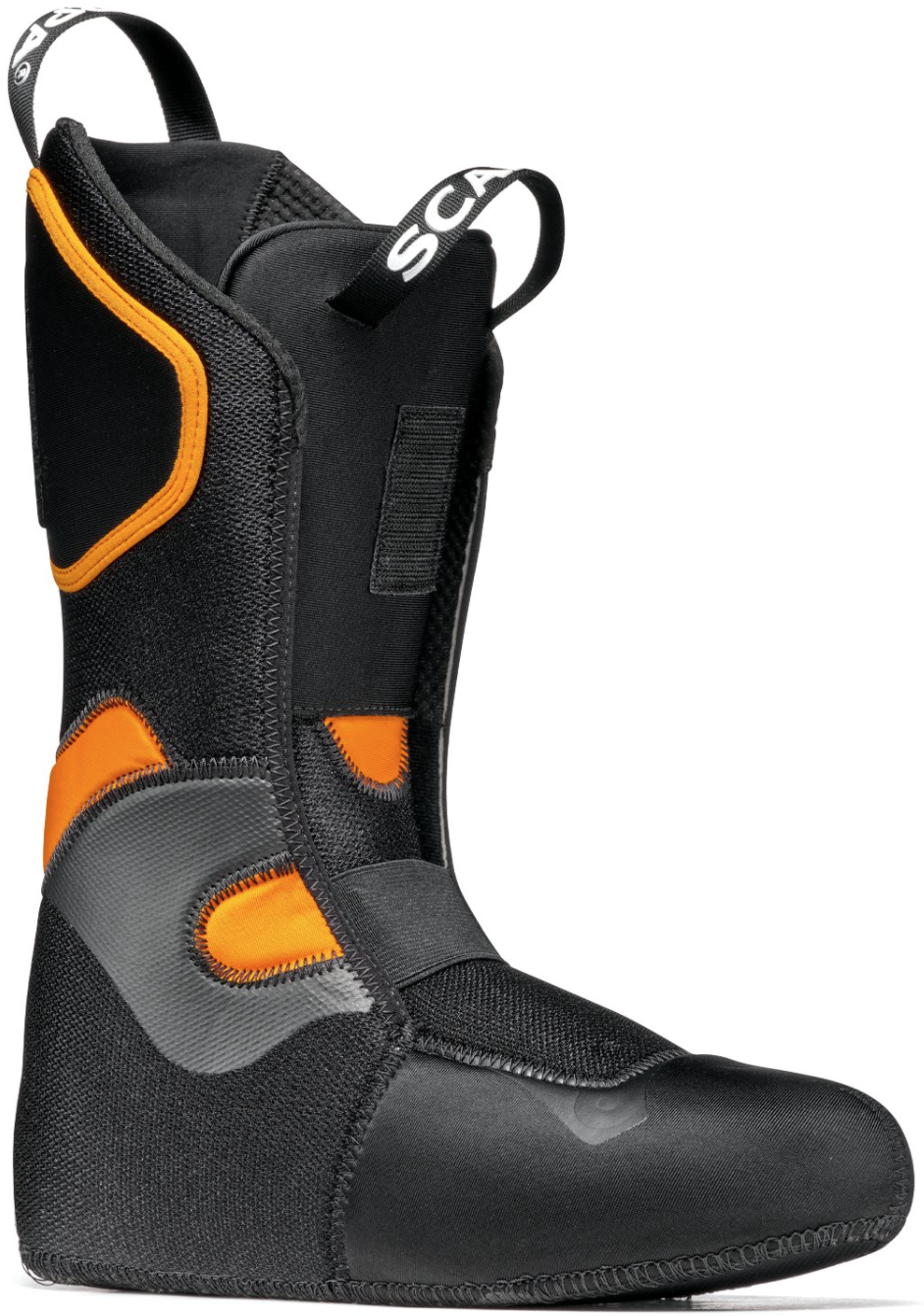 Stock F1 LT Intuition linerThis aspect is not perfect for me but likely suits many skiers with feet just wider than low volume. The stock Intuition liner (250 grams with some stick-on foam) of the LT is warm enough but seems to be packing out quickly. As a result, I’ve added some foam in the mid and forefoot with a piece over the instep for good measure. I’m pretty sure I could simply drop a Pro Tour liner (283 grams) in it and improve the fit but that will come with a $200 price tag and I'm not sure if the cuff will tolerate the volume. For now, I’m avoiding that. This boot won’t fit people with wide forefeet or large bunion deformities. The carbon grilamid can be punched carefully but voids the warrantee. The shell is one or two millimeters wider than the Alien RS and the BSL is the same. This makes for easy transition onto skis already drilled for the RS.
Stock F1 LT Intuition linerThis aspect is not perfect for me but likely suits many skiers with feet just wider than low volume. The stock Intuition liner (250 grams with some stick-on foam) of the LT is warm enough but seems to be packing out quickly. As a result, I’ve added some foam in the mid and forefoot with a piece over the instep for good measure. I’m pretty sure I could simply drop a Pro Tour liner (283 grams) in it and improve the fit but that will come with a $200 price tag and I'm not sure if the cuff will tolerate the volume. For now, I’m avoiding that. This boot won’t fit people with wide forefeet or large bunion deformities. The carbon grilamid can be punched carefully but voids the warrantee. The shell is one or two millimeters wider than the Alien RS and the BSL is the same. This makes for easy transition onto skis already drilled for the RS.
The Good
Tipping the scales at 1060 grams for my full-size 28 mondo, The F1 LT is as light or lighter than all boots in its class. It’s hard to overstate the importance of gear weight hanging from our feet when it comes to high performance adventure skiing. With a clever blend of material and shell structure, the LT lives up to the hype of being both light and stiff. The Carbon Grilamid LFT construction creates this magic. While the material is stiff all by itself, the addition of the exoskeleton-like shell structure is the trick.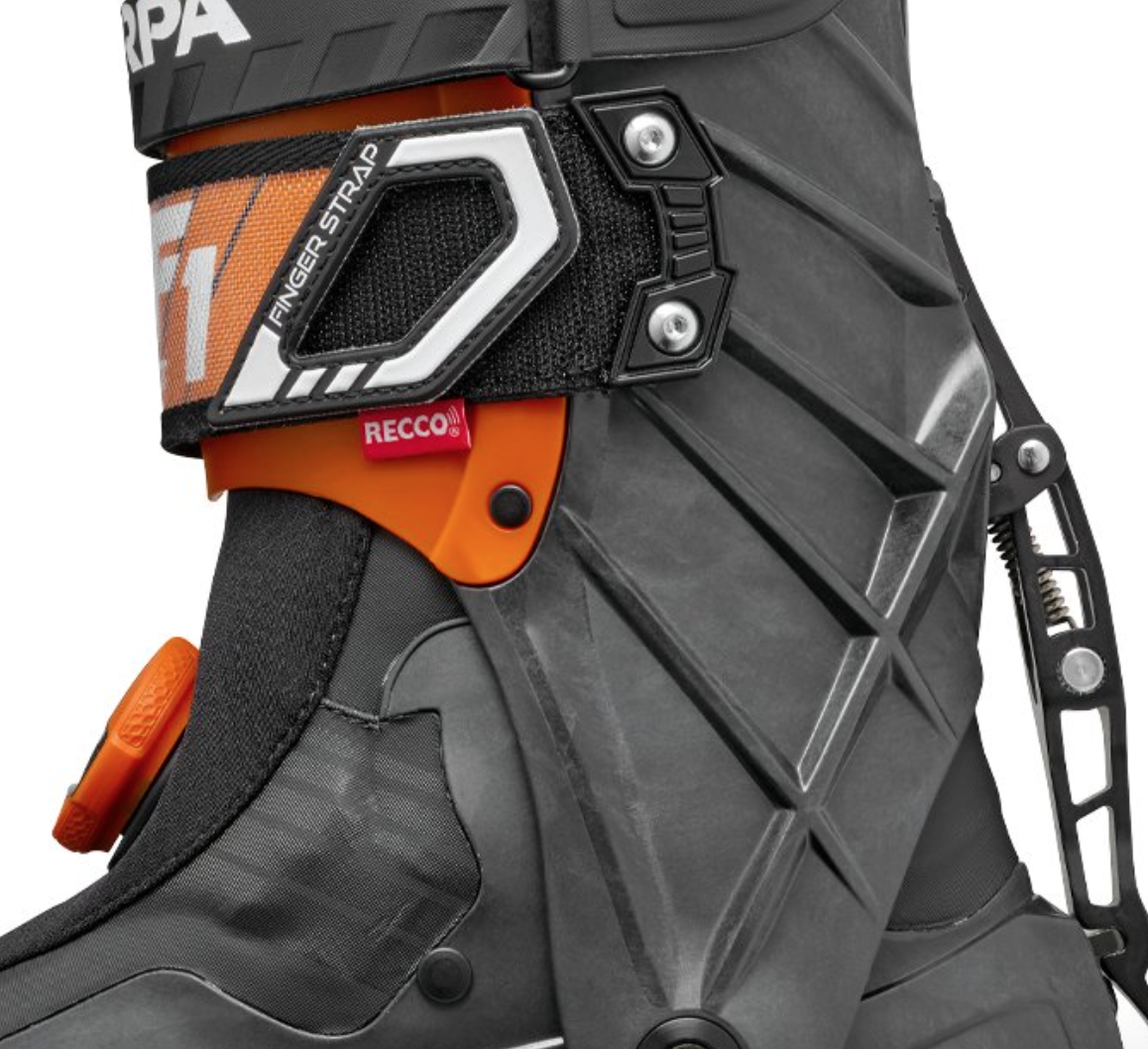
The BOA lacing system from many Scarpa models returns here to good effect. Now, I’m not enamored with this system having suffered a few failures over the years. 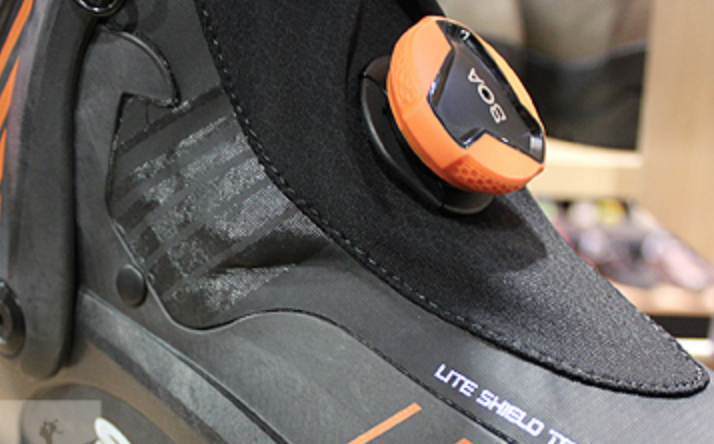 But my standard F1 survived two seasons without complaint so I’m relaxing on this point a bit. Indeed, the LT hides the lacing under the hood so the exposure to rock and edge trauma is minimized.
But my standard F1 survived two seasons without complaint so I’m relaxing on this point a bit. Indeed, the LT hides the lacing under the hood so the exposure to rock and edge trauma is minimized.
One of my favorite features is the heel latch. With the LT, Scarpa has disassociated the latch with the cuff tightening mechanism so popular on many race boots. This makes for an easy flick into the lock position without the usual gradual application of cuff force common elsewhere. This is a beautiful thing.  The standard F1 heel latch receiver is prone to icing in some conditions
The standard F1 heel latch receiver is prone to icing in some conditions F1 LT latch more resistant to icing and easier to cleanThe latch tab is also prominent and not buried in a little box like on the F1. This decreases icing issues so common in that boot after wallowing.
F1 LT latch more resistant to icing and easier to cleanThe latch tab is also prominent and not buried in a little box like on the F1. This decreases icing issues so common in that boot after wallowing.
Cuff tightening is accomplished with the wide Velcro strap and lever feature of the F1. 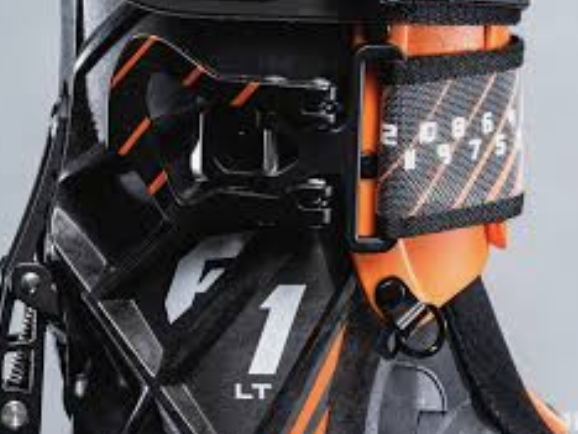 Once set at the car, there is only on and off to deal with at transitions. What this ultimately eliminates is the somewhat sketchy cord feature of the RS and other race boots. A cord is prone to eventual wear and failure. So nice to put that to bed with the LT.
Once set at the car, there is only on and off to deal with at transitions. What this ultimately eliminates is the somewhat sketchy cord feature of the RS and other race boots. A cord is prone to eventual wear and failure. So nice to put that to bed with the LT.
A simple but elegant improvement is the way the upper power strap fixes onto the shell. It is a tool-less affair which can be accomplished in seconds.  They’ve put a tricky curve on the strap which allows it to ride lower. I tried the boot without the strap and there is a loss of downhill capacity without it.
They’ve put a tricky curve on the strap which allows it to ride lower. I tried the boot without the strap and there is a loss of downhill capacity without it.
There is a nice gaiter that keeps almost all snow out of the shell. So far, there has been little to no wear at the contact points. We can revisit this issue in the spring.
The Bad
The first item on this list is the slight creep to a larger volume shell. I understand that they have to sell more boots and making a boot that fits more feet is a fine tactic to this end. But it does me no favors.
The BOA remains unsettled in my mind. I’d still rather have a buckle. We’ll see how it weathers the storm of a full season. One of mine is already acting a bit dodgy, feeling sticky. Not sure what to make of it. Perhaps a reader has some ideas?
The Velcro powerstrap has been trimmed down to a lighter affair which is nice. But Velcro is still prone to losing its grip and icing up. The additional irritating attraction to the inside of my pant leg makes me yearn for a simple cam buckle affair. Skimo Strap makes such an aftermarket item for the standard F1 and it’s a clear improvement. But the tricky curve of the strap on the LT makes this a non-starter without some tinkering. I’m planning on sewing one to the other with the help of a local cobbler and see if that will solve the issue.
One curious feature that takes some getting used to is the amount of forward lean available. While I recognize that this is a personal preference thing, the standard F1 goes up to 22* of lean where the LT only allows up to 13*. That’s a big difference. The position will feel very upright for those on race style bindings but may come as some relief with bindings with higher deltas like the Dynafit TLTs. Either way, this more upright position is easy to get used to and once your quads experience the lack of constant tension created by a more forward position, it’s hard to go back.
Another item that makes the “bad” column is getting the liner in and out of the shell for drying. This is a chore and requires burly finger strength. I’m sure I’m not making this easier with the addition of foam on my liners. And it’s unclear how I’d design it to be easier. It really is the gaiter feature that makes this problematic. The same is true for the Alien 1.0 race boot but the lighter liner is easy to overpower. I’ll likely just suck it up and continue to struggle when necessary. The benefit of having an effective gaiter is hard to dismiss.
Final thoughts
In my skiing career, it seems a decade is what separates bouts of design breakthroughs. The Scarpa F1 LT is the latest in 2020. For skiers who like to go farther and faster, it’s hard to find a boot more suited to that end. Like they say, “…if the shoe fits….”